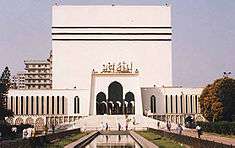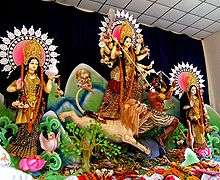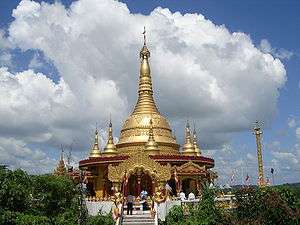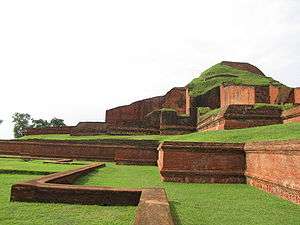Religion in Bangladesh
| Part of a series on the |
| Culture of Bangladesh |
|---|
|
Rice Bread Fish Sweets Snacks Sauce |
| Religion |
|
Architects Painters Sculptor |
|
Literature History Genres Institutions Awards Writers |
|
Music and performing arts |
|
Monuments |
|
Bangladesh is constitutionally a secular country. Although removed from the constitution once, it was later reinstated, but the constitution recognises Islam as the state religion of Bangladesh.[1] Islam is the largest religion of Bangladesh; Muslims constitute over 94% of the population, while Hindus and Buddhists are the most significant minorities of the country. Christians, Sikhs, animists and atheists form the minuscule remainders.[2] A survey in late 2003 confirmed that religion is the first choice by a citizen for self-identification. Bangladesh only recognises Islam, Christianity, Hinduism, and Buddhism.[3]
Religion in Bangladesh [4]
Islam


Muslims constitute over 94% percent of the population.[4] Muslims are the predominant community of the country and they form the majority of the population in all eight divisions of Bangladesh. Overwhelming majority of Muslims in Bangladesh are Bangladeshi Muslims, but a small segment of them are Biharis and Rohingyas. Most Muslims in Bangladesh are Sunnis, but there is a small Shia community and an even smaller Ahmadiyya community. Most of those who are Shia reside in urban areas. Although these Shias are few in number,[5] Shia observance commemorating the martyrdom of Muhammad's grandson, Husain ibn Ali, is widely observed by the nation's Sunnis.[6] Muslims celebrate Eid ul-Fitr, Eid ul-Adha, Muharram, Milad un Nabi, Shab-e-Barat and Chand Raat all across the country with much fanfare and grandeur. The annual Bishwa Ijtema is the largest and most notable congregation of Muslims in Bangladesh.
The Muslim community in the Bengal region developed independent of the dominant Islamic trends in India. Features of Bangladeshi Hinduism, which differed in some respects from Hinduism in other parts of South Asia, influenced both the practices and the social structure of the Bangladeshi Muslim community. In spite of the general personal commitment to Islam by the Muslims of Bangladesh, observance of Islamic rituals and tenets varies according to social position, locale, and personal considerations. In rural regions, some beliefs and practices tend to incorporate elements that differ from and often conflict with orthodox Islam.
Hinduism

.jpg)
Hinduism is the second largest religious affiliation in Bangladesh, with around 8.9 million people identifying themselves as Hindus. Hindus make up about 5% of the total population. In terms of population, Bangladesh has the third largest Hindu community of the world, after India and Nepal.[7] Bangladeshi Hindus are predominantly Bengali Hindus, but a distinct Hindu population also exists among the indigenous tribes like Garo, Khasi, Jaintia, Santhal, Bishnupriya Manipuri, Tripuri, Munda, Oraon, Dhanuk etc. Hindus are evenly distributed throughout all regions of Bangladesh, with significant concentrations in northern, southwestern and northeastern parts of the country. In nature, Bangladeshi Hinduism closely resembles the rituals and customs of Hinduism practised in the neighbouring Indian state of West Bengal, with which Bangladesh (at one time known as East Bengal) was united until the partition of India in 1947. Hindu festivals of Durga Puja, Rath Yatra and Janmashtami witness jubilant celebrations across various cities, towns and villages of Bangladesh. According to Statics Bureau Of Bangladesh There are 89,57,745 Hindus In Bangladesh and They Grow by -2% per Year. About 38% of Bangladeshi Hindus Live in Khulna Division.They Form Majority in Two Parliamentary Constitution (Gopalganj-1,Khulna-3) and make 40-50% in Other 27 Constituency.According To Survey Hindus Have Played Vital Role in 50 Parliamentary Constituency out of 300.Mostly Hindus Support Awami League and Communists Party of Bangladesh Who Committed to Secularism. Persecution of Hindus is Very Common Anti-Hindu Riots Killed Thousand of People and vandalized Hundred of Hindu Place of Worship.After Making Islam as State Religion Persecution Of Minorities (Mostly Hindu) increased. On 2016 Muslim mob attacked on Hindu Village Nasir nagar over false allegations of Demeaning Islam about 25 Hindu Temples Vandalize and 100 Hindu House Torched.A Series of Attacks Started after It According to Bangladesh Leading Newspaper Dhaka tribune There are 55 Hindu Temple Vandalize d Across Bangladesh and 300 Hindu Houses Burned By Muslim.On 1 to 5 December 2016 Hindu Goddess Kali Idol Beheaded in Netrakona District and 20 Hindu Dalit House Burnt In Durhapur.In Recent Attack 5 Hindu Temples Vandalize in Pabna.All Attack is Same As 2014 Anti-Hindu Violence.Opposition Along With Rolling Party Politician Were Involve in Persecution of Hindu.According to Survey After Recent Attacks 20,000 Hindu Families Left Bangladesh And There are 0.6 Million Hindu Left Bangladesh since December Due to religious Persecution.Hindu Have Seemed as Indian Agnet and Anti-Islamic in Views of Common Bangladeshi Muslim And Rise of Islmaization Minorities Become Kafir (Non Muslim or Murerderable) And Support of Government Makes Situation Complicated For Minorities Specially Hindus. According to Professor of Dhaka University There Will Be No Hindu Left After 30 Years In Bangladesh.
Buddhism


About 2,000,000 people in Bangladesh adhere to the Theravada school of Buddhism. Buddhists form about 0.6% of the population of Bangladesh.
In antiquity, the region of present-day Bangladesh was a center of Buddhism in Asia. Buddhist civilisation, including philosophies and architecture, traveled to Tibet, Southeast Asia and Indonesia from Bengal. The Buddhist architecture of Cambodia, Indonesia and Thailand, including the Angkor Wat Temple and the Borobudur vihara, are believed to have been inspired by the ancient monasteries of Bangladesh such as the Somapura Mahavihara. Strange though it may now seem in such an overwhelmingly Muslim country, Buddhism has been no small player in the nation's history and culture.
Most of the followers of Buddhism in Bangladesh live in the Chittagong division. Here, Buddhism is practised by the Bengali-speaking Baruas, who are almost exclusively Buddhist and are concentrated heavily in the Chittagong area as well as few of the Barua Buddhists live in other parts of Bangladesh, such as Comilla, Mymensingh, Rangpur, Sylhet districts. Most of the followers of Buddhism in Bangladesh live in southeastern region, especially in the Chittagong Hill Tracts, Chittagong and Comilla district. Most of the Buddhists of Chittagong Hill Tracts belong to the Chakma, Marma, Mru, Khumi, Bawm, Chak, Kuki, Murang, Tanchangya and Khiang tribes, who since time immemorial have practised Buddhism. Other tribal communities who practise animism, have come under some Buddhist influence. The beliefs and rituals of the Buddhist communities in this region are amalgamations of Buddhism and ancient animistic faiths. Buddha Purnima is the most widely observed festival among both Bengali Buddhists and Buddhist tribes.
Christianity
Christianity arrived in what is now Bangladesh during the late sixteenth to early seventeenth centuries AD, through the Portuguese traders and missionaries. Christians account for approximately 0.3% of the total population and they are mostly urban community. Roman Catholicism is predominant among the Bangladeshi Christians, while the remaining few are mostly Protestants. Few followers of Christianity are also present among certain indigenous tribal communities such as Lushei, Bawm etc.
Other religions
Sikhism

There are approximately 100,000 people adhering to the religion of Sikhism. The presence of this religion goes back to the visiting of Guru Nanak at 1506–07 with some of his followers to spread Sikhism in the region of the present day Bangladesh. When some Bengali people accepted this faith then a Sikh community was born.[8] This community had became bigger when almost 10,000 Sikhs came from India during the Bangladesh Liberation War. This community had made a great progress to the country. Today there are almost 10 gurdwaras in Bangladesh.[9] Among them only 7 are well-known especially the Gurdwara Nanak Shahi beside the University of Dhaka in Dhaka which was built in 1830, the most oldest gurdwara in Bangladesh.
Law, religion, and religious freedom
Although Bangladesh initially opted for a secular nationalist ideology as embodied in its Constitution, the principle of secularism was subsequently replaced by a commitment to the Islamic way of life through a series of constitutional amendments and government proclamations between 1977 and 1988. The Constitution establishes Islam as the state religion.[10] But also there is secularism in Bangladesh which recently came back.[11] The Government generally respects this provision in practice; however, some members of the Hindu, Christian, Buddhist, and Ahmadiyya communities experience discrimination. The Government (2001-2006), led by an alliance of four parties (Bangladesh Nationalist Party, Bangladesh Jamaat-e-Islami, Islami Oikya Jote and Bangladesh Jatiyo Party) banned the Ahmadiyya literature by an executive order.
Family laws concerning marriage, divorce, and adoption differ depending on the religion of the person involved. There are no legal restrictions on marriage between members of different faiths.
In 2010, secularism was restored, but Islam remained the state religion per Article 12.[12]
Persecution of minorities
There have been several instances of violence against the religious minorities in Bangladesh. Hindus, Buddhists and Christians have come under widespread attacks by Islamist extremists during communal riots, elections and post-poll violence. However, most of these violences are perpetrated primarily against Hindus, the largest minority of the country, who are particularly vulnerable in a period of rising violence and extremism, whether motivated by religious, political or criminal factors, or some combination. Bangladesh has been rocked by several anti-Hindu riots in 1992, 2001, 2013 and 2014. These violences included attacking and killing Hindus, looting and burning of Hindu-owned properties and businesses, abduction and rape of women, desecrating and destroying Hindu temples by the extremist Muslim mobs. There are also alleged discrimination against Hindus by the administration in the form of Vested Property Act by which over 40% of Hindu-owned lands and houses have been confiscated, intimidation during elections and revoking their names from electoral rolls. Since the rising of Islamist political parties during 1990s, large number of Hindu families have migrated from Bangladesh to India due to a sense of insecurity and economic necessity. These factors combined with lower birth rates of minorities have resulted in a dwindling Hindu population in the country. The Bihari ethnic minority in Bangladesh has been subject to persecution during and after 1971 Liberation War. Due to their pro-Pakistan stance, many Biharis were forcefully repatriated to Pakistan and those who stayed back were not granted citizenship and voting rights by Bangladesh government.
Atheism
Atheism is not common in Bangladesh.[13] According to a 2014 WIN/GIA survay, 5% of respondents from Bangladesh identify as irreligious.[14]
There have been multiple attacks and murders of atheist bloggers, academics and authors by Islamist militants since 2013, with the government accused of being unable or unwilling to provide protection – and in some cases even persecuting atheists and imprisoning them.
References
- ↑ "The Constitution of The People's Republic Of Bangladesh Article 12: Secularism and freedom of religion". State.gov.
- ↑ "Bangladesh Religion - Muslim Hindu Buddhis Christian". MediaBangaldesh.net. Retrieved 2015-12-09.
- ↑ "The Constitution of The People's Republic Of Bangladesh". State.gov. Retrieved 2015-07-17.
- 1 2 ১০ বছরে ৯ লাখ হিন্দু কমেছে [10 years 9 million fewer Hindus]. Prothom Alo (in Bengali). 22 September 2012. Retrieved 2014-11-14.
- ↑ France-Presse, Agence (2015-10-24). "One killed and scores wounded in attack at Shia site in Bangladesh capital". The Guardian. ISSN 0261-3077. Retrieved 2016-03-27.
- ↑ "Islam in Bangladesh". OurBangla. Archived from the original on 2012-02-10.
- ↑ "[Analysis] Are there any takeaways for Muslims from the Narendra Modi government?". DNA. 27 May 2014. Retrieved 2014-05-31.
- ↑ "Bangladesh-Gurudwaras of World".
- ↑ Mohanta, Sambaru Chandra (2012). "Gurdwara Nanak Shahi". In Islam, Sirajul; Jamal, Ahmed A. Banglapedia:National Encyclopedia of Bangladesh (Second ed.). Asiatic Society of Bangladesh.
- ↑ "The Constitution of The People's Republic of Bangladesh". Laws of Bangladesh. Legislative and Parliamentary Affairs Division, Government of Bangladesh.
- ↑ "Secularism and freedom of religion". bdlaws.minlaw.gov.bd. Retrieved 2016-03-27.
- ↑ Constitution of the People's Republic of Bangladesh, Article 12: Secularism and freedom of religion
- ↑ Khan, Razib (13 May 2015). "Atheists in Bangladesh May Not be Totally Doomed".
- ↑ "End of Year Survey 2014: Regional & Country Results".
![]() This article incorporates public domain material from the Library of Congress Country Studies website http://lcweb2.loc.gov/frd/cs/.
This article incorporates public domain material from the Library of Congress Country Studies website http://lcweb2.loc.gov/frd/cs/.
